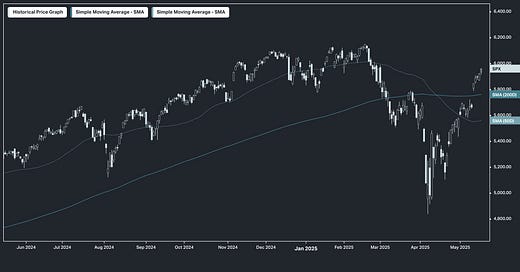Home Court
Wall Street closed the week on a high note, with all three major indexes posting solid weekly gains, buoyed by easing US-China trade tensions.
The S&P 500 rose 0.7% on Friday, marking its fifth consecutive daily gain, while the Nasdaq added 0.4% and the Dow advanced 331 points, erasing year-to-date losses.
However, soft consumer sentiment data slightly tempered the rally, as the University of Michigan’s index fell to 50.8—its second-lowest reading on record—while one-year inflation expectations jumped to 7.3%.
For the week, the S&P 500 gained 5.3%, the Dow rose 3.4%, and the Nasdaq surged 7%.
For investors, that home court advantage lies above the S&P 500’s 200-day moving average. On March 7, the index fell below this key level, followed by a “death cross” on April 14, when the 50-day moving average crossed below the 200-day. Last week, on May 12, the S&P 500 roared back above its 200-day moving average, signalling a potential shift.
The index has erased its year-to-date losses and now sits just 3.7% below its February intra-day high. This swift five-week recovery, among the fastest since the late 1980s, points to a classic event-driven bear market.
Recent data supports this rebound: Q1 earnings, non-farm payrolls, retail sales, and inflation figures have consistently exceeded expectations. This momentum suggests the uptrend may continue, providing breathing room for markets and policymakers to finalise key deals, potentially lifting economic expectations further.
Q1 Report Card: Strong Earnings, Aggressive Buybacks
Corporate America delivered robust Q1 results, with 4% revenue growth and 12% earnings per share growth year over year. While U.S. exceptionalism may face headwinds, earnings haven’t yet reflected a slowdown. Companies seized April’s sell-off as a buying opportunity, with corporate stock buybacks totalling $234 billion - the second-highest monthly figure on record, just shy of April 2022’s $243 billion. Buyback demand is projected to continue at $4 billion daily through mid-June, providing a tailwind for stock prices.
Active Managers Regain Confidence
The National Association of Active Investment Managers (NAAIM) Exposure Index has rebounded from mid-April lows to its five-year average of 71, matching late February levels. While not predictive, this recovery signals active managers see a favourable risk/reward environment. Sentiment is clearly on the mend, aligning with improving market technicals and fundamentals.
Position Your Portfolio for Success
Take highly asymmetric bets riding global trends by becoming a member:
For better risk-adjusted returns, check out our Quantitative Strategies / Market Signals Report.









